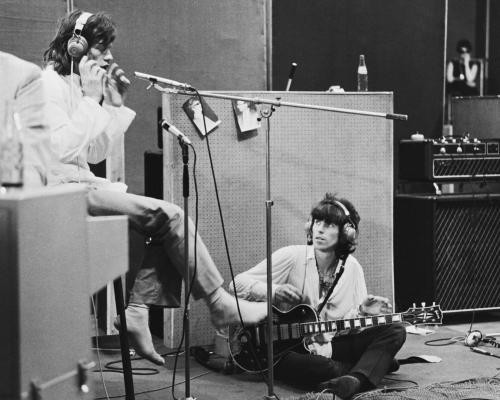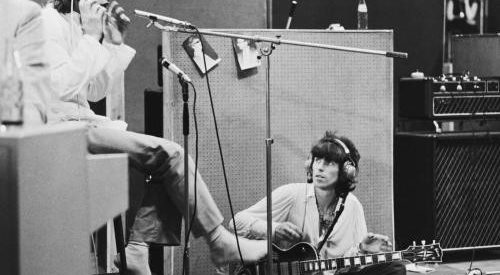
Over the last 50 years the Jagger/Richards songwriting partnership has produced some of the most controversial yet innovative Rock N Roll songs, which have had a massive impact on society. For example when ?Street Fighting Man? was released many radio stations banned it due to race & student protests it helped inspire. However, when The Rolling Stones released ?Sympathy For The Devil? all hell broke lose as Mick Jagger literally sings in first person as the devil.
Background and inspiration
The main lyrical inspiration for ?Sympathy For The Devil? come from a combination of sources Mick Jagger referenced back in 1968. One known source is Charles Baudelaire the French writer and the other is Russian author Mikhail Bulgakov?s novel ?The Master And The Margarita?. His then girlfriend Marianne Faithfull gifted the latter to him. The book features the Russian writer skillfully blending fantasy with social satire. Baudelaire for example compares the life of Jesus Christ with that of an artist in Soviet Russia, against the backdrop of arbitrary attest and psychiatric hospitals.
There are two main concepts of his work that are featured heavily in the song, which are the reversal of values and the confusion of reality and appearance. In the song this is referenced as the devil being featured as a man with taste, and every cop is a criminal while every sinner saints. Even Christ is remembered for his pain but also for his moments of doubt. As these lyrics mentally register with the listener one may begin to think has evil trumped over good? That being said it?s nothing more than fantasy despite Mick Jagger?s persistence towards the end of the song by yelling, ?Tell me baby, what?s my name? Tell me honey, can ya guess my name?? Apart from the religious themes featured in the song Jagger references other important events that occurred in the twentieth century, which is the October Revolution, the assassination of the Tsar and his ministers, WWII & the assassination of the Kennedy Brothers. If you look closely enough Jagger almost wrote the lyrics in a ?Dylanesque poetic verse?
In reality the message of ?Sympathy For The Devil? is hardly different from that of ?Gimme Shelter? as the philosophy of Peace and Love as heard on ?All You Need Is Love? was dead even before it began. The realities of the 60?s will be the Vietnam War and the violence that carried forward into the 70?s.
Recording of the Song
?The first time I ever heard the song was when Mick was playing it at the front door of a house I lived in Sussex. It was at dinner; he played it entirely on his own, the sun was going down and it was fantastic?
Charlie Watts on the first time he heard Sympathy for the devil
One may assume that the Jagger/Richards songwriting partnership works in a way where Jagger would write the lyrics and Keith Richards would write the music. However, nothing could be further than the truth as in this instance Mick Jagger wrote both the lyrics & the music for Sympathy for the devil. Keith Richards?s contribution was assisting Mick in helping him find his rhythm. He is quoted saying, ?I was just trying to figure out if it was a Samba or a goddam folk song?. This can be witnessed thanks to the movie Sympathy For The Devil, which Jean-Luc Godard filmed as the band was recording the song at Olympic Studios. Here you can see the transformation of the song as it develops from a folk song to an epic Rock N Roll samba, which incorporates Brazilian dance musical elements.
The movie also provided a unique insight into how The Stones operated in the studio, where the division of roles was divided amongst various musicians. Mick Jagger provided the vocals, as he was keen to communicate with the band members effectively and uses diplomacy to be understood. Keith Richards is the bandleader as he teaches his ideas to the troops and looks for ways to make his ideas a reality. Bill Wyman who?s more antisocial than ever submits to the wishes of the pair and does as he?s told. Charlie Watts, who?s barely more cheerful than Bill does the same, while Brian Jones is isolated by the three acoustic panels, seems miserable and alone. However, despite it taking the band 30 takes of the folk version of the song to realize they needed to up the tempo to it, which is when it was transformed to the samba version, little by little the definitive version of ?Sympathy For The Devil? that we love and adore today was slowly coming to life.
Break down of the song
The most iconic element of the song has to be the drums that are played by Charlie Watts, which has nothing in common with the Brazilian Rock Elements the song is notable for. Instead he sticks to his roots and plays a Jazz Latin feel that Kenny Clarke would have played on ?A Night In Tunisia?. Not the actual rhythm just the styling. However, the main Congo drumbeats you hear on the track were played by Rocky Dijon. Bill Wyman joins in on these beats with a shekere, which is an African percussion instrument similar to the maracas, while front man Mick Jagger emits a number of shrieks, which are boosted by delay. Keith Richards brings out his Fender Percussion bass that?s plugged into Bill?s Vox Foundation amp, his immaculate playing is further accompanied by Nicky Hopkins outstanding piano playing that is notable for joining the first verse ?Please allow me to introduce myself?. In the film Brian Jones can be seen playing his new, Gibson acoustic, which is the J-200. However, this track may have been suppressed in the final mix or take a back seat to all the other instruments featured on the track.
The lead guitar phrases, heard half-way through the song were recorded by Keith Richards on his Les Paul Black Beauty. Lastly, the iconic ?Woo Woo? heard by the backing vocalists were sung by Anita Pallenberg, Marianne Faithfull, Suki Potier (Brian?s new girlfriend) Glyn Johns, and the main members of the band.
Aftermath
As the opening track of The Band?s seventh British and ninth American album ?Beggars Banquet?, the song sets the tone for the record. It can be considered as Mick Jagger?s most iconic performance as his talent lights up the band. Critics of the song started labelling the band as ?devil worshippers? of, which Mick Jagger in an interview with Creem magazine said ?[When people started taking us as devil worshippers], I thought it was a really odd thing, because it was only one song, after all. It wasn?t like it was a whole album, with lots of occult signs on the back. People seemed to embrace the image so readily, [and] it has carried all the way over into heavy metal bands today. Some people have made a living out of doing this; for example, Jimmy Page.?
When asked again about the change in public perception of the band after the song?s released he mentioned in an interview with Rolling Stone ?Before, we were just innocent kids out for a good time, they?re saying, ?They?re evil, they?re evil.? Oh, I?m evil, really? So that makes you start thinking about evil? What is evil? Half of it, I don?t know how much people think of Mick as the devil or as just a good rock performer or what? There are black magicians who think we are acting as unknown agents of Lucifer and others who think we are Lucifer. Everybody?s Lucifer.?


